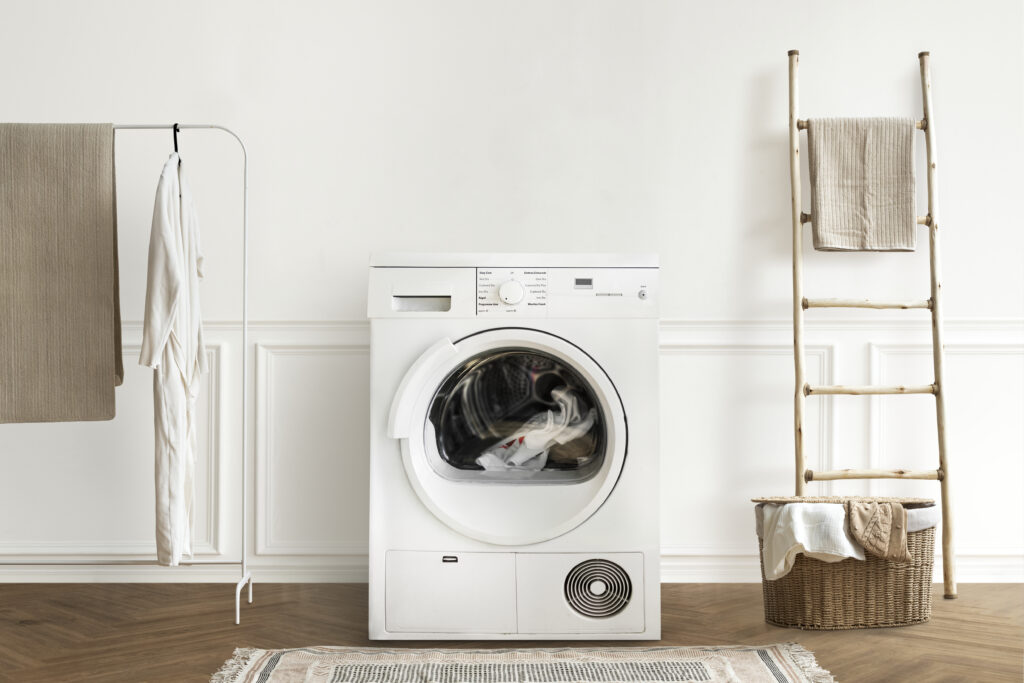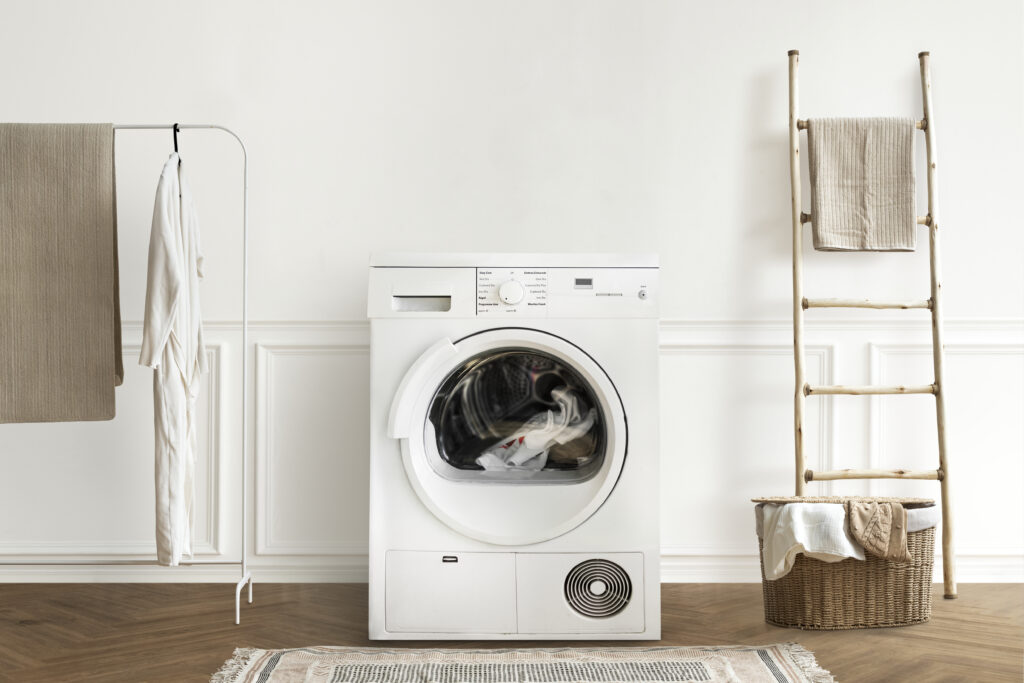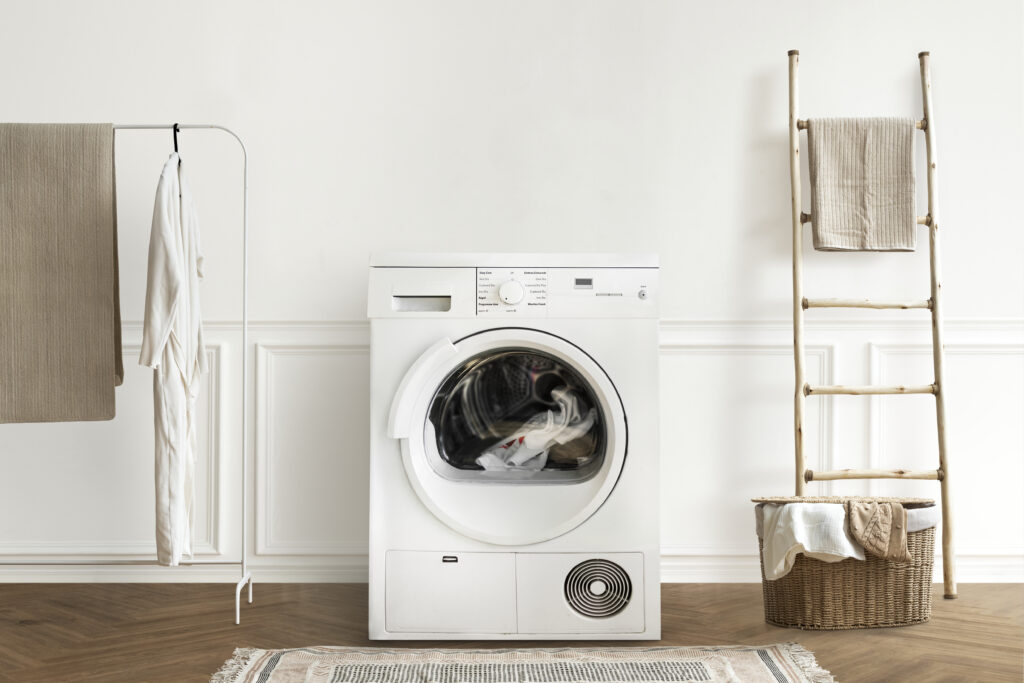One of the most annoying home issues is a washing machine that is overflowing with water, particularly if your clothes are left soaking and the machine won’t drain. Knowing how to properly empty your washing machine can prevent water damage and ruined clothes, regardless of the cause—a clog, a mechanical issue, or a power outage.
We’ll explain why your washer may fill up and stop draining, how to safely empty it, and what you can do to avoid this issue in the future in this comprehensive 2025 guide for homes in the USA.

What Causes a Washing Machine to Fill with Water and Not Empty?
A washing machine may stop draining due to a number of problems, leaving water trapped inside:
1. Blockage in the Drain Hose
Small objects, detergent buildup, or lint can clog the drain hose, stopping water from coming out of the washer.
2. Drain Pump Filter Blocked
To capture debris before it reaches the drain hose, the majority of contemporary washers come equipped with a drain pump filter. Water won’t drain correctly when it’s clogged.
3. A malfunctioning drain pump
Water may stay in the drum if the drain pump malfunctions.
4. Outage of Power During Cycle
The draining cycle may be stopped by an unplanned power outage, leaving your washer full of water.
5. Incorrectly Positioned Drain Hose
Inappropriate drainage or siphoning may result from a drain hose that is too high or too low.
Safety Measures Before You Begin
Prior to emptying your washer:
To prevent electric shock, unplug the washing machine from the electrical outlet.
Close the hot and cold water supply valves on the wall.
Get a mop or towels ready in case there are spills.
Prepare a bucket or shallow container to catch water that is draining.

Step-by-Step Instructions for Draining a Washing Machine of Water
A washing machine’s standing water can be safely removed in a few different ways. Here is a trustworthy, detailed guide:
✅ Step 1: Repeat the Drain/Spin Cycle
A simple reset can be helpful at times:
Reinstall the washer’s plug.
Only choose the “Drain” or “Spin” cycle.
Check to see if the machine drains after starting it.
Go ahead and manually empty it if it still won’t drain.
✅ Step 2: The Preferred Method: Use the Drain Hose
Find the drain hose on your washer and use it:
The washer should be moved forward a little.
The drain hose, usually a flexible black or gray tube, is located at the back.
Put a shallow bowl or container underneath the end of the hose.
Take the hose out of the utility sink or standpipe.
Water will flow out of the container when the hose end is lowered into it due to gravity.
Continue to empty the container until the washer is completely dry.
Pro Tip: Water may not drain if the drain hose is clogged. If so, move on to Step 3.
✅ Step 3: Use the Front-Load Washers’ Drain Pump Filter
The majority of front-loading washers feature a tiny access panel:
Locate a panel close to the washer’s front bottom.
Put a shallow pan and towels underneath.
The panel door should open.
Water will begin to flow out as you slowly unscrew the drain pump filter cap.
Before replacing, let it drain completely, clear the filter of any debris, and clean it.
Be ready with towels and extra pans if necessary because water can flow quickly.
✅ Step 4: Use a bucket and sponge to manually remove the water
If you are unable to reach the filter or drain hose:
For top-loading washers, open the door; for front-loading washers, if the water level allows, manually unlock the door latch.
Scoop out as much water as you can using a tiny container.
Use a towel or sponge to absorb any leftover water.
Advice: This is a laborious but efficient last option.
Step 5: While you’re at it, look for clogs in the drain hose:
Take the hose off all the way.
To get rid of any obstructions, run hot water through it.
For tough debris, use a snake tool or flexible brush.
Other Tips for Troubleshooting
After emptying, if your washer still won’t drain:
Examine the drain pump: Pay attention to any humming or grinding noises made during the drain cycle, as these could indicate a malfunctioning or jammed pump.
Examine the utility sink or standpipe: Backup may result from a clogged home drain.
Examine the pressure switch; draining may be prevented by a malfunctioning pressure sensor.

How to Stop Water from Filling Up Your Washing Machine and Not Draining
Future headaches can be avoided with a little upkeep and care. What you can do is as follows:
✅ Regularly Clean the Drain Pump Filter
To avoid clogs caused by lint and debris, check and clean the drain pump filter on your washer once a month.
Steer clear of overloading the washer.
An excessive amount of laundry puts stress on the drain system and washer motor, raising the possibility of drainage problems.
Make Use of Proper Detergent
Always use HE detergent in high-efficiency (HE) washers to avoid excessive suds that can clog drain systems and sensors.
✅ Fit the Drain Hose with a Lint Trap
Lint and debris are captured by this low-cost accessory before they can clog the drain pipe.
Every 6 to 12 months, inspect and clean the drain hose.
Check for obstructions, kinks, or bends.
When to Make a Professional Call
If the washer still won’t drain or error codes are still present after you’ve emptied it:
It might be time to replace the drain pump.
Sensors or internal wiring may be broken.
It’s possible that the control board is malfunctioning.
The typical cost of repairs in the USA is between $150 and $350. You can avoid more damage and expensive water cleanup services by getting a diagnosis and repair done early.

In conclusion
If you take the proper precautions, emptying a washing machine full of water is doable. These methods will enable you to address the issue safely and promptly, whether you’re using the drain hose, getting to the pump filter, or scooping the water out by hand.
Frequent drain system inspections, careful detergent use, and routine washer maintenance will keep your machine operating efficiently and stop future drainage issues.
📌 A Brief Overview: How to Drain a Washing Machine of Water
Methods/Steps Required
Try the spin/drain cycle.Restart cycle selection
Make use of the drain hose.Clean the drain pump filter with a bucket, towel, and hose end lowered into a container.Access panel opening, unscrewing, draining, and cleaning
Use a sponge to manually removeRemove any remaining water with a scoop and soak it with towels.
Examine and clean the drain hose.Remove, flush with hot water, and use a snake if necessary.